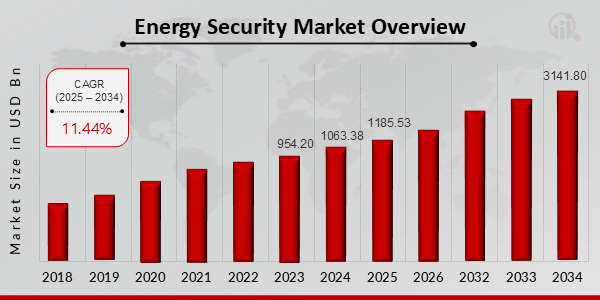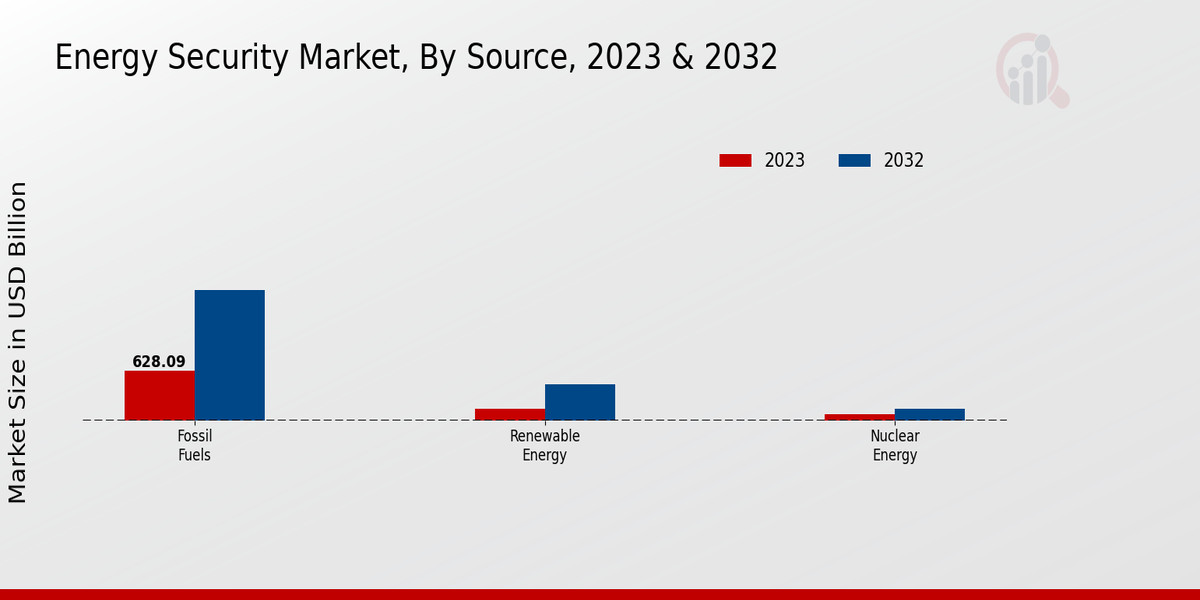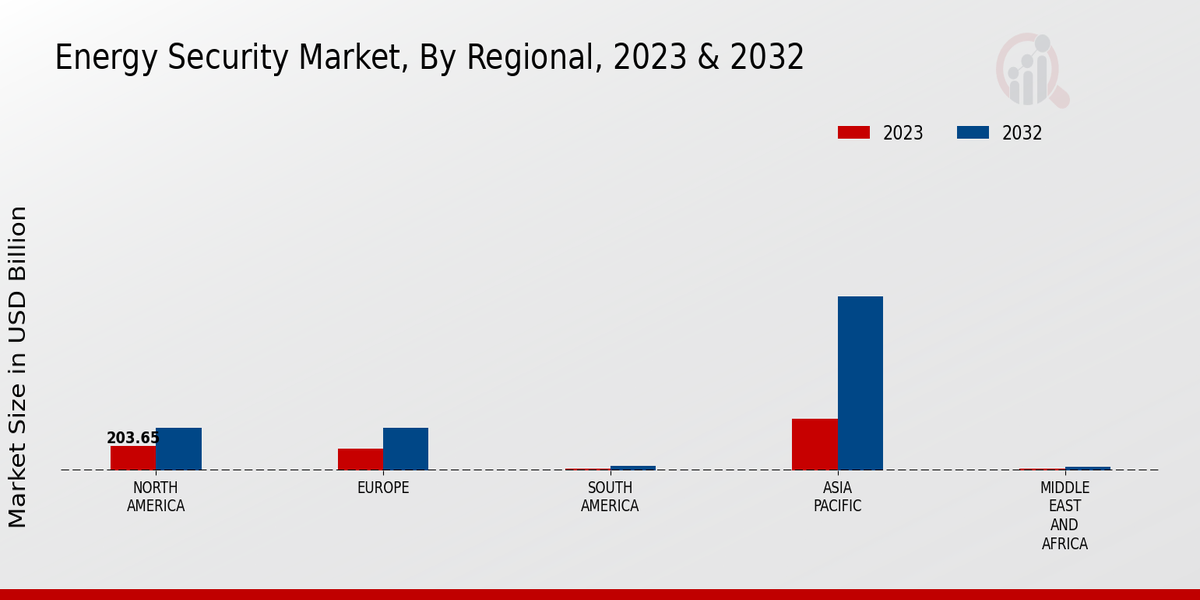Energy Security Market Overview
Energy Security Market is projected to grow from USD 1185.53 Billion in 2025 to USD 3141.80 Billion by 2034, exhibiting a compound annual growth rate (CAGR) of 11.44% during the forecast period (2025 - 2034). Additionally, the market size for Energy Security Market was valued at USD 1063.38 billion in 2024.
Key Energy Security Market Trends Highlighted
The Energy Security Market is experiencing significant growth due to rising geopolitical tensions and the growing importance of ensuring reliable energy supplies. Key market drivers include increased demand for energy sources, particularly in emerging economies, and concerns over climate change and the need for sustainable energy solutions. Opportunities for growth lie in the development of renewable energy infrastructure, smart grids, and energy storage systems. Another prominent trend is the integration of artificial intelligence and digital technologies into energy security systems to enhance efficiency and resilience.
Moreover, collaborations between governments, industries, and international organizations are shaping the market by facilitating research, innovation, and policy development. As the world grapples with increasing demand, environmental concerns, and geopolitical risks, the Energy Security Market is poised for substantial expansion in the coming years.
Figure 1: Energy Security Market, 2025 - 2034

Source: Primary Research, Secondary Research, MRFR Database and Analyst Review
Energy Security Market Drivers
Growing Demand for Energy Security
One of the most significant industrial drivers of the Energy Security Market is the constantly increasing demand for energy security. Along with the global population, the energy demand is growing as well. There are a number of key driving factors that increase the demand for energy:- The emerging middle class of developing countries, the rising utilization of new energy-consuming technologies, the growing demand for transportation facilities, including developed infrastructure and vehicles, the imperative to substitute the deteriorating energy structure.
The constantly increasing demand for energy has a significant impact on energy resources because they are scarce and exhaustible. The load on energy resources is expected to continue increasing because of emerging factors. Therefore, there is a significant demand for energy security. In the context of the report, energy security is defined as a concept of a country’s ability to maintain necessary energy provision capabilities on extreme terms, including supply reliability and payment affordability.
There are several specific ways to increase energy security, which can be implemented through the development and manufacturing of needed solutions in the target industry:- The increase of domestic energy production in each country- Energy source diversification- The enhancement of energy efficiency technologies- The invention and development of energy storage facilities and solutions.
The Energy Security Market is expected to be one of the most rapidly developing in the current century since the demand for energy is constantly increasing, as was already mentioned. There are a number of other particular driving factors that could be identified:- The increase in energy demand- The rise of the environmental and energy security importance of society- The enhancement of new technologies used in energy production and processing processes. However, the specific evaluation of their impact cannot be provided, as they are not the direct cluster variables.
Increasing Government Support
The Increasing concern of governments around the world with energy security is leading to growing government support for the Energy Security Market in a variety of forms. Financial incentives for investment in energy security technologies, regulations that promote energy security, and research and development funding for energy security technologies are examples of government support for the Energy Security Market. This Government support is driving the growth of the Energy Security Market and is expected to continue in the future.
Technological Advancements
Technological advancements are also playing a major role in the growth of the Energy Security Market. These advancements are leading to the development of new energy security technologies that are more efficient, affordable, and reliable. Some of the most promising technological advancements in the Energy Security Market include:- Renewable energy technologies- Energy storage technologies- Smart grid technologies. These technologies are helping to make energy security more achievable for countries around the world. As these technologies continue to develop, the Energy Security Market is expected to grow even faster.
Energy Security Market Segment Insights
Energy Security Market Source Insights
The Energy Security Market is subdivided by source of energy into fossil fuels, renewable energy, nuclear energy, and other sources. Currently, fossil fuels which are oil, gas, and coal, dominate the market, constituting over 80% of the total global production. However, the market is predicted to shift towards renewable sources of energy though time, such as solar and wind power. This occurs because of the falling production cost and lower running costs of renewable sources. Moreover, it is considered to be more sustainable than fossil fuels, hence driving its growth.
The growth of the renewable energy source is also driven by government policies and consumer demand. The role of nuclear energy in the energy security of the future is considerable as it is reliable and low in carbon. However, its further development is usually stalled due to public apprehension concerning the construction of new nuclear power plants. Other sources of energy, such as geothermal and biomass, also serve to contribute to the total future global energy mix.
Figure 2: Energy Security Market, By Condition, 2023 & 2032

Source: Primary Research, Secondary Research, MRFR Database and Analyst Review
Energy Security Market Infrastructure Insights
The infrastructure segment is crucial to the Energy Security Market, accounting for a significant portion of revenue. Power plants, the backbone of energy generation, are projected to grow at a CAGR of 12% from 2024 to 2030. Transmission lines, responsible for transporting electricity over long distances, are expected to witness a 10% CAGR during the same period. Distribution networks, which deliver electricity to end consumers, are anticipated to expand at an 8% CAGR. Storage facilities, essential for balancing supply and demand, are poised for a remarkable 15% CAGR. Other essential infrastructure components, including smart grids and renewable energy integration solutions, are also contributing to the segment's growth.
Energy Security Market Policy and Regulation Insights
Policy and Regulation segment plays an influential role in the Energy Security Market, shaping its landscape and driving market growth. Government policies, industry regulations, international agreements, and other regulatory frameworks establish the guidelines and standards for energy security practices. Government policies, such as energy security strategies and national action plans, set long-term goals, prioritize investments, and provide incentives for the development and adoption of secure energy solutions.
Industry regulations, implemented by regulatory bodies and agencies, enforce safety, reliability, and environmental standards, ensuring the responsible and sustainable operation of energy systems. International agreements, like the Paris Agreement on climate change, foster global cooperation and establish common frameworks for addressing energy security challenges. These agreements promote the adoption of renewable energy sources, energy efficiency measures, and international collaboration on energy infrastructure and technology development. The Energy Security Market is expected to witness significant growth in the coming years due to increasing demand for reliable and sustainable energy sources. Government policies and regulations play a crucial role in driving this growth by providing a conducive environment for investment and innovation in energy security solutions.
Energy Security Market Cybersecurity Insights
The Cybersecurity segment of the Energy Security Market is projected to grow significantly in the coming years, driven by increasing concerns over cyber threats to critical energy infrastructure. The global cybersecurity market in the energy and utilities sector is expected to reach USD 42.86 billion by 2027, exhibiting a CAGR of 9.2% during the forecast period. Physical security measures, cybersecurity measures, data protection, and other cybersecurity solutions are crucial for safeguarding energy assets and ensuring the reliability and resilience of the energy grid. Stringent government regulations and compliance requirements are also contributing to the growth of the cybersecurity market in the energy sector.
Energy Security Market Regional Insights
The Energy Security Market is segmented into North America, Europe, APAC, South America, and MEA. Among these regions, North America and Europe are expected to hold the largest market shares in the coming years. The major factors driving the growth of the Energy Security Market in these regions include increasing energy demand, stringent government regulations, rising security concerns, and technological advancements. In 2023, the North American Energy Security Market is expected to be valued at USD 324.56 billion, and it is projected to reach USD 556.23 billion by 2032, exhibiting a CAGR of 6.1%.
Europe is expected to follow a similar growth trajectory, with the market size reaching USD 298.15 billion by 2032, growing at a CAGR of 5.8%. APAC is expected to witness the fastest growth rate, with the market size reaching USD 694.87 billion by 2032, growing at a CAGR of 7.9%. South America and MEA are also expected to contribute to the growth of the global market, albeit at a slower pace.
Figure 3: Energy Security Market, By Regional, 2023 & 2032

Source: Primary Research, Secondary Research, MRFR Database and Analyst Review
Energy Security Market Key Players and Competitive Insights
Major players in the Energy Security Market are constantly investing in research and development to enhance their product offerings and gain a competitive edge. Leading Energy Security Market players are focusing on developing innovative solutions that improve energy efficiency, reliability, and security. The Energy Security Market is expected to witness significant growth in the coming years due to increasing demand for energy security solutions. The competitive landscape of the Energy Security Market is characterized by the presence of both established and emerging players.
One of the leading players in the Energy Security Market is Siemens, a global technology company that provides a wide range of energy security solutions, including smart grid technologies, cybersecurity solutions, and microgrids. Siemens has a strong presence in the market and has been recognized for its innovative solutions and commitment to energy security. The company has a global reach and has successfully implemented energy security projects in various countries around the world.
A notable competitor in the Energy Security Market is Schneider Electric, a French multinational company that provides energy management and automation solutions. Schneider Electric offers a comprehensive portfolio of energy security solutions, including energy management systems, power distribution systems, and uninterruptible power supplies. The company has a strong global presence and has established itself as a leading provider of energy security solutions. Schneider Electric is known for its expertise in energy management and its commitment to providing reliable and efficient energy solutions.
Key Companies in the Energy Security Market Include
- Chevron
- ExxonMobil
- Saudi Aramco
- Petrobras
- Marathon Petroleum
- ConocoPhillips
- Equinor
- Gazprom
- PetroChina
- Lukoil
- BP
- Royal Dutch Shell
- TotalEnergies
- Eni
Energy Security Market Developments
Recent developments include the Russia-Ukraine conflict, which has highlighted the importance of energy security and led to increased investments in renewable energy sources. Additionally, the growing demand for energy in emerging economies and the transition towards cleaner energy sources are driving market growth. Key players in the market include Honeywell International Inc., Siemens AG, and Schneider Electric SE.
Energy Security Market Segmentation Insights
-
Energy Security Market Source Outlook
- Fossil Fuels
- Renewable Energy
- Nuclear Energy
- Other Sources
-
Energy Security Market Infrastructure Outlook
- Power plants
- Transmission lines
- Distribution networks
- Storage facilities
- Other Infrastructure
-
Energy Security Market Policy and Regulation Outlook
- Government policies
- Industry regulations
- International agreements
- Other Policy and Regulation
-
Energy Security Market Cybersecurity Outlook
- Physical security
- Cybersecurity measures
- Data protection
- Other Cybersecurity
-
Energy Security Market Regional Outlook
- North America
- Europe
- South America
- Asia Pacific
- Middle East and Africa
|
Report Attribute/Metric
|
Details
|
|
Market Size 2024
|
1063.38 (USD Billion)
|
|
Market Size 2025
|
1185.53 (USD Billion)
|
|
Market Size 2034
|
3141.80 (USD Billion)
|
|
Compound Annual Growth Rate (CAGR)
|
11.44% (2025 - 2034)
|
|
Report Coverage
|
Revenue Forecast, Competitive Landscape, Growth Factors, and Trends
|
|
Base Year
|
2024
|
|
Market Forecast Period
|
2025 - 2034
|
|
Historical Data
|
2019 - 2023
|
|
Market Forecast Units
|
USD Billion
|
| Key Companies Profiled |
Chevron, ExxonMobil, Saudi Aramco, Petrobras, Marathon Petroleum, ConocoPhillips, Equinor, Gazprom, PetroChina, Lukoil, BP, Royal Dutch Shell, TotalEnergies, Eni |
| Segments Covered |
Source, Infrastructure, Policy and Regulation, Cybersecurity, Regional |
| Key Market Opportunities |
Renewable energy integration Cybersecurity enhancements Distributed energy systems Smart grid infrastructure Energy storage advancements |
| Key Market Dynamics |
Rising energy demand, geopolitical instability, climate change, energy transition, and technological advancements |
| Countries Covered |
North America, Europe, APAC, South America, MEA |
Frequently Asked Questions (FAQ) :
The Energy Security Market is projected to reach a valuation of approximately 954.20 billion USD in 2023.
The Energy Security Market is estimated to exhibit a robust Compound Annual Growth Rate (CAGR) of 11.44% during the forecast period from 2025 to 2034.
The increasing global energy demand, coupled with concerns over energy security, geopolitical uncertainties, and the transition towards renewable energy sources, are key factors propelling the growth of the Energy Security Market.
The Asia-Pacific region is projected to dominate the Energy Security Market, owing to the increasing energy consumption and growing investments in energy infrastructure development in countries like China and India.
Energy security solutions find applications across various sectors, including residential, commercial, industrial, and transportation. They are employed to ensure a reliable and sustainable supply of energy, mitigate risks associated with energy disruptions, and reduce energy costs.
Key players in the Energy Security Market include Siemens, Schneider Electric, Honeywell International, ABB, General Electric, Emerson Electric, Eaton Corporation, Rockwell Automation, and Lockheed Martin.
The Energy Security Market is witnessing trends such as the adoption of smart grid technologies, integration of renewable energy sources, increasing focus on energy efficiency, and growing investments in cybersecurity measures to protect critical energy infrastructure.
The COVID-19 pandemic had a significant impact on the Energy Security Market, leading to disruptions in energy supply chains, reduced energy demand, and increased focus on energy resilience and self-sufficiency.
The Energy Security Market faces challenges such as geopolitical conflicts, climate change, technological disruptions, and the need for substantial investments in energy infrastructure development.
The Energy Security Market is projected to reach a valuation of approximately 3141.80 billion USD by 2034, representing a significant growth opportunity for stakeholders in the industry.

















